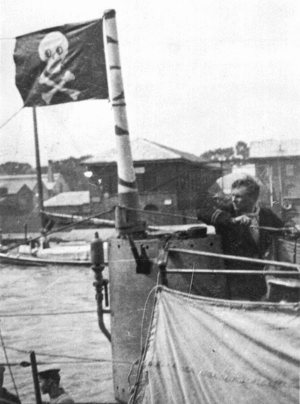HMS H5
 A view from the bridge of HMS H5. | |
| Career | |
|---|---|
| Name: | HMS H5 |
| Builder: | Canadian Vickers, Montreal |
| Launched: | June 1915 |
| Fate: | Sunk, 2 March 1918 |
| General characteristics | |
| Class and type: | H class submarine |
| Displacement: | 363 long tons (369 t) surfaced 434 long tons (441 t) submerged |
| Length: | 150 ft 3 in (45.80 m) |
| Beam: | 15 ft 4 in (4.67 m) |
| Propulsion: | 1 × 480 hp (358 kW) diesel engine 2 × 620 hp (462 kW) electric motors |
| Speed: | 13 knots (24 km/h; 15 mph) surfaced 10 knots (19 km/h; 12 mph) submerged |
| Range: | 1,600 nmi (3,000 km) at 10 kn (19 km/h; 12 mph) surfaced 130 nmi (240 km) at 2 kn (3.7 km/h; 2.3 mph) submerged |
| Complement: | 22 |
| Armament: | • 4 × 18 in (457 mm) bow torpedo tubes • 8 × 18 inch torpedoes |
HMS H5, was a British H-class submarine of the Royal Navy. She was sunk after being rammed by the British merchantman Rutherglen, mistaken for a German U-boat, on 2 March 1918. All on board perished.
Stoker Petty Officer Thomas Lloyd was among the casualties. He, and all the rest of the crew are commemorated on Panel 29 at Royal Navy Submarine Museum. Also on board was US Navy Lt. Earle Wayne Freed Childs from the American submarine AL-2 as an observer, he became the first US submariner to lose his life in the First World War. The wreck site is designated as a controlled site under the Protection of Military Remains Act.
A plaque commemorating the 26 who died was dedicated on Armed Forces Day 2010 in Holyhead[1]
References
- ↑ "Ceremony for Armed Forces Day marks submarine tragedy". BBCNews (BBC). 19 June 2010. Retrieved 1 July 2010.
- MCA website: controlled sites under the Protection of Military Remains Act
- SI 2008/950 Designation under the Protection of Military Remains Act 1986
| ||||||||||||||||||||||||||